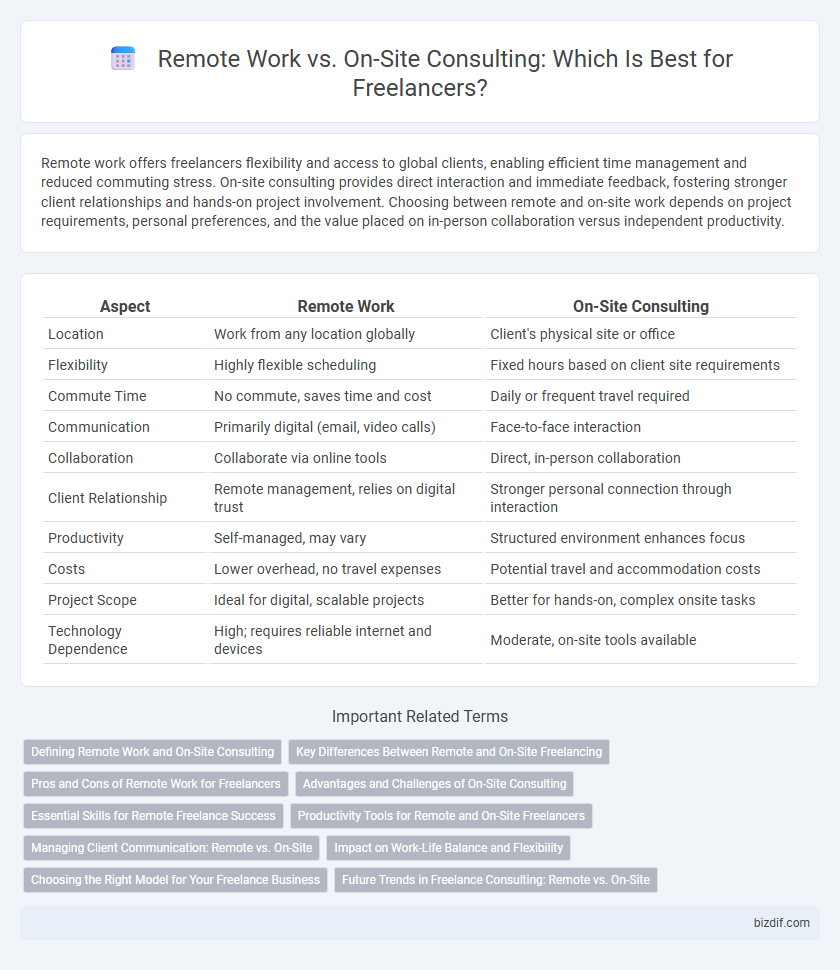Remote work offers freelancers flexibility and access to global clients, enabling efficient time management and reduced commuting stress. On-site consulting provides direct interaction and immediate feedback, fostering stronger client relationships and hands-on project involvement. Choosing between remote and on-site work depends on project requirements, personal preferences, and the value placed on in-person collaboration versus independent productivity.
Table of Comparison
| Aspect | Remote Work | On-Site Consulting |
|---|---|---|
| Location | Work from any location globally | Client's physical site or office |
| Flexibility | Highly flexible scheduling | Fixed hours based on client site requirements |
| Commute Time | No commute, saves time and cost | Daily or frequent travel required |
| Communication | Primarily digital (email, video calls) | Face-to-face interaction |
| Collaboration | Collaborate via online tools | Direct, in-person collaboration |
| Client Relationship | Remote management, relies on digital trust | Stronger personal connection through interaction |
| Productivity | Self-managed, may vary | Structured environment enhances focus |
| Costs | Lower overhead, no travel expenses | Potential travel and accommodation costs |
| Project Scope | Ideal for digital, scalable projects | Better for hands-on, complex onsite tasks |
| Technology Dependence | High; requires reliable internet and devices | Moderate, on-site tools available |
Defining Remote Work and On-Site Consulting
Remote work in freelancing involves professionals performing tasks and collaborating with clients entirely through digital platforms, enabling flexibility and access to global opportunities. On-site consulting requires freelancers to be physically present at a client's location, facilitating direct interaction and immediate problem-solving. Both approaches offer distinct advantages depending on project requirements, communication preferences, and the nature of deliverables.
Key Differences Between Remote and On-Site Freelancing
Remote freelancing offers flexibility with location-independent work, allowing professionals to collaborate globally using digital communication tools, while on-site consulting requires physical presence, fostering direct client interactions and immediate feedback. Productivity in remote work relies heavily on self-discipline and virtual project management platforms, contrasting with on-site environments where face-to-face teamwork and real-time problem-solving are prevalent. Client trust and relationship building can vary significantly, as remote freelancers depend on consistent digital communication whereas on-site consultants benefit from personal engagement and local networking opportunities.
Pros and Cons of Remote Work for Freelancers
Remote work for freelancers offers flexibility in schedule and location, enabling access to a global client base and reducing commuting costs. However, this mode can lead to challenges such as limited face-to-face interaction, potential isolation, and difficulties in maintaining clear communication with clients. The reliance on digital tools and stable internet connections is crucial for productivity and timely project delivery in remote freelancing.
Advantages and Challenges of On-Site Consulting
On-site consulting offers the advantage of direct client interaction, fostering stronger relationships and immediate problem-solving, which can enhance project outcomes and client satisfaction. Challenges include higher travel costs and time commitments, potentially reducing flexibility compared to remote work. However, the immersive environment of on-site consulting allows for better understanding of organizational culture and real-time collaboration with teams.
Essential Skills for Remote Freelance Success
Mastering communication tools and self-discipline are essential skills for remote freelance success, enabling seamless collaboration and adherence to deadlines across time zones. Proficiency in digital project management platforms enhances task organization and client interaction efficiency, contributing to project consistency and transparency. Adaptability to evolving technology and proactive problem-solving foster resilience and competitiveness in the dynamic landscape of remote freelancing.
Productivity Tools for Remote and On-Site Freelancers
Productivity tools for remote freelancers include project management software like Trello and Asana, time-tracking apps such as Toggl, and communication platforms like Slack and Zoom, enabling seamless collaboration and task management. On-site consultants benefit from tools like Microsoft Office Suite, physical planners, and portable devices that support face-to-face interaction and immediate problem-solving. Both work environments rely on cloud storage solutions like Google Drive and Dropbox to ensure accessibility and data synchronization across devices.
Managing Client Communication: Remote vs. On-Site
Managing client communication in remote work relies heavily on digital tools like video conferencing, instant messaging, and collaborative platforms to maintain clarity and responsiveness. On-site consulting enables face-to-face interactions, fostering immediate feedback, non-verbal cues, and stronger personal connections. Effective communication strategies tailored to each setting are crucial for project success and client satisfaction in freelancing.
Impact on Work-Life Balance and Flexibility
Remote work in freelancing significantly enhances work-life balance by allowing flexible schedules and eliminating commuting time, which reduces stress and increases productivity. On-site consulting often demands fixed hours and physical presence, limiting flexibility and potentially increasing work-related fatigue. Choosing remote freelancing enables professionals to better integrate personal and professional responsibilities, promoting overall well-being and sustained performance.
Choosing the Right Model for Your Freelance Business
Choosing between remote work and on-site consulting depends on project requirements, client expectations, and your freelance business goals. Remote work offers flexibility, broader client reach, and lower operational costs, while on-site consulting fosters deeper client relationships and hands-on collaboration. Assessing factors like time zone differences, communication preferences, and travel feasibility ensures alignment with your productivity and income targets.
Future Trends in Freelance Consulting: Remote vs. On-Site
The future of freelance consulting is increasingly shaped by remote work, leveraging digital collaboration tools and cloud platforms to enhance flexibility and access to global clients. On-site consulting remains valuable for projects requiring direct client interaction, complex problem solving, and hands-on engagement. Hybrid models that blend remote efficiency with periodic on-site presence are rapidly gaining traction, offering optimized productivity and client satisfaction.
Remote Work vs On-Site Consulting Infographic

 bizdif.com
bizdif.com